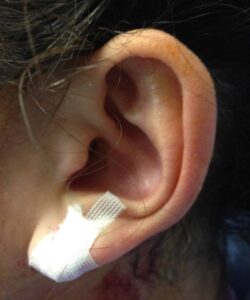Earlobe Repair
 If you have a torn earlobe , either from a baby grabbing it, catching on clothes…we can help!
If you have a torn earlobe , either from a baby grabbing it, catching on clothes…we can help!
In less than an hour in the office, our Board Certified Cosmetic Surgeon can fix that torn earlobe.
If you are trying to land that dream job, or get into the service, you may be rethinking that gauge. we can help you too.
Post-op care is minimal, often not much more then ear piecing care. stitches are removed after 10-14 days and the earlobe can be repierced in a few months.
How soon after earlobe repair can earrings be worn again?
The timeline for wearing earrings after earlobe repair depends on the specific instructions provided by your surgeon. In general, here’s an overview:
- Immediate Post-Surgery Period: In the initial days after earlobe repair, it’s typical to avoid wearing any earrings. This allows the incisions to heal without any additional stress or weight.
- Stitch Removal: If stitches are used, they are usually removed within the first week after the procedure. After stitch removal, your surgeon may advise you on when it’s safe to start wearing earrings again.
- Gradual Reintroduction: Even after stitch removal, it’s common for surgeons to recommend a gradual reintroduction of earrings. This may involve starting with lightweight earrings and avoiding heavy or dangling styles for an extended period.
- Individual Healing: The overall healing process varies among individuals. Some people may be able to wear earrings sooner, while others may need to wait a bit longer.
How long does the entire earlobe repair process, from consultation to recovery, usually take?
The duration of the entire earlobe repair process can vary based on individual factors and the specific circumstances of the procedure. However, here’s a general overview:
- Consultation: This is typically the initial step, where you discuss your concerns, goals, and medical history with the surgeon. Consultations can range from 30 minutes to an hour.
- Scheduling the Procedure: Once you decide to proceed with earlobe repair, the scheduling of the surgery may take a few weeks to a month, depending on the surgeon’s availability.
- Surgery Time: The actual earlobe repair surgery is a relatively quick procedure, often taking less than an hour.
- Recovery: Recovery time can vary but is generally around 1 to 2 weeks. During this period, you may experience swelling and bruising, and it’s essential to follow postoperative care instructions.
Can Earlobe Repair Fix Deformities or Asymmetry?
Yes, earlobe repair is a good choice if you are looking to fix any asymmetry or deformities! Doesn’t matter whether they were caused by trauma, stretching or they were like that from the start, everything can be fixed about them. During the procedure your earlobe will be reshaped by removing extra tissues, reconstructing the lobe or stitching torn areas to help them achieve symmetrical appearance. Although the procedure seems quite simple, the results are based on a lot of different factors such as surgeon’s skills, and the nature of asymmetry. Which is why it’s important to make sure you are getting the treatment from a qualified professional, it will highly increase the chances of desired results.
How To Prepare For Earlobe Repair Surgery? Do I Need Preparation Even For A Fresh Earlobe Damage?
Preparation for earlobe repair does depend on whether you have fresh injury or it’s an older one. If the injury is new then it’s important to clean the wound to make sure risks of infection are prevented, but normally you don’t need preparations, and cleaning will be done at hospital. But if it’s a planned earlobe repair then it’s best to avoid wearing any earrings, avoiding alcohol, smoking, and blood thinning medications at least a week before the treatment since they can make it hard for the body to heal.
Can Both Earlobe Be Repaired At The Same Time?
Yes, you can get both of your earlobes treated during the same sessions, especially if your overall health is good and there are no contraindications. In fact, it’s actually quite common to repair both earlobes, especially for those with asymmetrical tears or deformities. The procedure requires numbing the earlobes with anesthesia and repairing the damage through sutures or other techniques. Afterwards, all you need to worry about is post-procedure care.
Home
